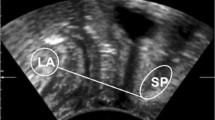Abstract
The aims of the study were (1) to assess the reliability of transabdominal (TA) and transperineal (TP) ultrasound during a pelvic floor muscle (PFM) contraction and Valsalva manoeuvre and (2) to compare TA ultrasound with TP ultrasound for predicting the direction and magnitude of bladder neck movement in a mixed subject population. A qualified sonographer assessed 120 women using both TA and TP ultrasound. Ten women were tested on two occasions for reliability. The reliability during PFM was excellent for both methods. TP ultrasound was more reliable than TA ultrasound during Valsalva. The percentage agreement between TA and TP ultrasound for assessing the direction of movement was 85% during PFM contraction, 100% during Valsalva. There were significant correlations between the magnitude of the measurements taken using TA and TP ultrasound and significant correlations with PFM strength assessed by digital palpation.





Similar content being viewed by others
References
Bo K et al (2001) Dynamic MRI of the pelvic floor muscles in upright sitting. Neurourol Urodyn 20:167–174
Bo K et al (1988) Knowledge about and ability to correct pelvic floor muscle exercises in women with urinary stress incontinence. Neurourol Urodyn 7:261–262
Benvenuti F et al (1987) Re-educative treatment of genuine stress incontinence. Am J Phys Med 66:155–168
Bump RC et al (1991) Assessment of Kegel pelvic muscle exercise performance after brief verbal instruction. Am J Obstet Gynecol 165(2):322–327; discussion 327–329
Theofrastous JP et al (1997) Relationship between urethral and vaginal pressures during pelvic muscle contraction. The Continence Program for Women Research Group. Neurourol Urodyn 16(6):553–558
Van Loenen N, Vierhout M (1997) Augmentation of urethral pressure profile by voluntary pelvic floor contraction. Int Urogynecol J 8:284–287
Thompson J, O’Sullivan P (2003) Levator plate movement during voluntary pelvic floor muscle contraction in subjects with incontinence and prolapse: a cross sectional study and review. Int Urogynecol J 12(4):84–88
Koelbl H, Bernaschek G (1989) A new method for sonographic urethrocystography and simultaneous pressure-flow measurements. Obstet Gynecol 74(3 Pt 1):417–422
Schaer G et al (1995) Perineal ultrasound for evaluating the bladder neck in urinary stress incontinence. Obstet Gynaecol 85:220–224
Schaer GN et al (1996) Perineal ultrasound: determination of reliable examination procedures. Ultrasound Obstet Gynecol 7(5):347–352
Peschers U et al (1996) Changes in vesical neck mobility following vaginal delivery. Obstet Gynaecol 88:1001–1006
Dietz H, Wilson P (1998) Anatomical assessment of the bladder outlet and proximal urethra using ultrasound and video-cystourethrography. Int Urogynecol J 9:365–369
Dietz HP, Wilson PD, Clarke B (2001) The use of perineal ultrasound to quantify levator activity and teach pelvic floor muscle exercises. Int Urogynecol J Pelvic Floor Dysfunct. 12(3):166–168; discussion 168–9
Dietz HP, Steensma AB, Vancaillie TG (2003) Levator function in nulliparous women. Int Urogynecol J Pelvic Floor Dysfunct 14(1):24–26; discussion 26
Brandt F et al (2000) Perineal assessment of the urethrovesical junction mobility in young continent females. Int Urogynecol J 11:18–22
Bo K, Sherburn M, Allen T (2003) Transabdominal ultrasound measurement of pelvic floor muscle activity when activated directly or via a transversus abdominis muscle contraction. Neurourol Urodyn 22(6):582–588
O’Sullivan PB et al (2002) Altered motor control strategies in subjects with sacroiliac joint pain during the active straight-leg-raise test. Spine 27(1):E1–E8
Thompson J, O’Sullivan P (2003) Levator plate movement during voluntary pelvic floor muscle contraction in subjects with incontinence and prolapse: a cross sectional study and review. Int Urogynecol J 12(4):84–88
Thompson J et al (2003) A comparison between transabdominal and transperineal ultrasound in the assessment of women performing pelvic floor exercises. Aust N Z Continence J 9(4):92–93
Thompson J et al (2004) Pelvic floor elevation during pelvic floor muscle contraction in women with incontinence and normal controls. ICS web site. In: Proceedings of the joint ICS/ IUGA meeting, August, Paris
Murphy C, Sherburn M, Allen T (2002) Investigation of transabdominal diagnostic ultrasound as a clinical tool and outcome measure in the conservative measurement of pelvic floor muscle dysfunction. In: Proceedings of the international continence society meeting, Heidelberg, Abstract 129, p 61
Sandvik H et al (1993) Validation of a severity index in female urinary incontinence and its implementation in an epidemiological survey. J Epidemiol Community Health 47(6):497–499
Ishiko O et al (2000) The urinary incontinence score in the diagnosis of female urinary incontinence. Int J Gynaecol Obstet 68:131–137
Dietz H, Wilson P, Clarke B (2001) The use of perineal ultrasound to quantify levator activity and teach pelvic floor muscle exercises. Int Urogynecol J 12:166–169
Sapsford R, Bullock-Saxton J, Markwell S (1998) Women’s health. A textbook for physiotherapists. WB Saunders, London
Thompson J et al (2004) Motor control strategies involved in pelvic floor elevation and depression. ICS web site. In: Proceedings of the joint ICS/ IUGA meeting, August, Paris
Dietz HP (2004) Levator function before and after childbirth. Aust N Z J Obstet Gynaecol 44(1):19–23
Peschers UM et al (2001) Bladder neck mobility in continent nulliparous women. BJOG 108(3):320–324
Peschers UM et al (1997) Levator ani function before and after childbirth. Br J Obstet Gynaecol 104(9):1004–1008
Dietz HP, Jarvis SK, Vancaillie TG (2002) The assessment of levator muscle strength: a validation of three ultrasound techniques. Int Urogynecol J Pelvic Floor Dysfunct 13(3):156–159; discussion 159
White R et al (1980) Real-time ultrasonography in the evaluation of urinary stress incontinence. Am J Obstet Gynecol 138:235–239
Acknowledgements
The authors thank Curtin University Postgraduate Scholarship Awards and the Physiotherapy Research Foundation of Australia for financial assistance. The support from Dr Anthony Murphy for use of ultrasound equipment, Nicole David for the preparation of the graphics and Ritu Gupta for statistical advice is gratefully acknowledged.
Author information
Authors and Affiliations
Corresponding author
Rights and permissions
About this article
Cite this article
Thompson, J.A., O’Sullivan, P.B., Briffa, K. et al. Assessment of pelvic floor movement using transabdominal and transperineal ultrasound. Int Urogynecol J 16, 285–292 (2005). https://doi.org/10.1007/s00192-005-1308-3
Received:
Accepted:
Published:
Issue Date:
DOI: https://doi.org/10.1007/s00192-005-1308-3




